A Geospatial Livestock-Carrying Capacity Model (GLCC) in the Akmola Oblast, Kazakhstan
Abstract
:1. Introduction
2. Materials and Methods
2.1. A GLCC Modeling Framework
- AF = Available forage (kg/ha/year), the proportion of ANPP that is accessible and suitable for livestock consumption, adjusted for factors such as plant toxicity and species-specific preferences, known as aboveground non-forage productivity (ANFP) and grazing efficiency (GE, default 35%).
- ANPP = Aboveground net primary production (kg/ha/year), the total biomass produced by vegetation, which serves as the primary source of forage.
- GA = The total area (ha) available for livestock grazing.
- DFI = Daily feed intake (kg/day/animal), specific to livestock species (e.g., cattle vs. goats).
- DU = Days of use, the duration of the grazing season, reflecting the period over which forage is utilized.
- D, W, S = Adjustments for climate extremes such as climate-related droughts (D), distance to water (W), and terrain slope (S).
2.2. Model Parameterization
2.2.1. Remotely Sensed Parameters
- MODIS NPP (1 km spatial resolution, annual composites) aligns with the temporal and spatial scales of forage production dynamics.
- Landsat-based LULC (30 m resolution) discriminates between grazable rangelands, non-forage vegetation (e.g., forests, urban areas), and water bodies, directly informing GA and ANFP (non-forage biomass).
- SRTM DEM (30 m resolution) calculates slope gradients, with adjustments applied to reflect reduced grazing efficiency in steep terrain.
2.2.2. Grazing Area, GA
2.2.3. Terrain Slope, S
- Slopes ≤ 15%: Minimal adjustment (S = 100%), as the terrain does not restrict grazing efficiency (e.g., Akmola Oblast, Figure 4).
- Slopes > 15%: Progressive reduction in S (e.g., S = 70–90%), reflecting reduced livestock mobility, forage utilization in mountainous regions, higher erosion risks due to significantly higher runoff
2.2.4. Distance to Water Area, W
- Identify accessible water sources: Seasonal water bodies within grazing areas (e.g., streams, ponds) are prioritized, excluding inaccessible permanent reservoirs.
- Compute distance thresholds: For each grazing pixel, Euclidean distance to the nearest accessible water source is calculated using GIS tools.
- Apply adjustment factors:
- ○
- ≤3 km to water: Minimal reduction (W = 100%), reflecting optimal grazing efficiency.
- ○
- >3 km: Progressive reduction (e.g., W = 70–90%), based on empirical observations of livestock-grazing radius limitations.
2.2.5. Aboveground Net Primary Productivity and Available Forage
2.3. Model Validation and Application
2.3.1. In Situ Data
- Vegetation Sampling
- Standing biomass (kg/ha): Sampled from five 0.25 m² quadrats per site, dried, and weighed.
- Species composition: Plant species identified, with density classified into five categories (1–10, 11–100, 101–500, 501–1000, >1000 plants).
- Foliar/ground cover (%): Measured via line-point intercept (100 points/transect), distinguishing life forms (bunchgrass, sodgrass, forb, shrub, etc.).
- Plant height (mm) and litter biomass: Recorded to assess forage structure and residue.
- Soil and Topographic Data
- Soil properties: Texture, pH, organic carbon, and color analyzed from top 25 mm samples.
- Slope, aspect, and terrain shape: Georeferenced to align with SRTM DEM-derived variables (S).
- Management Context
- Grazing intensity: Classified as none, light, moderate, or heavy continuous grazing (April–October).
- Water access: Proximity to seasonal/permanent sources noted for W adjustment validation.
- Geographic and Environmental Data
- Geographic coordinates (latitude and longitude) were recorded for each site.
- Terrain characteristics, including slope steepness, shape, length, and aspect, were documented.
- Climatic conditions during the sampling period were noted.
3. Results
- There is a significant spatial variability across the Oblast in livestock-carrying capacity with a general decreasing trend from south to north and localized high-and-lows, suggesting that a spatially variable grazing management practice is needed, as detailed in Section 3.1.
- There is a significant annual temporal variability in livestock-carrying capacity across the region, indicating that forage availability differs from year to year possibly due to annual variations in climate or grazing pressure. This suggests challenges in livestock management planning because of uncertainties in weather patterns, as detailed in Section 3.2.
- There is therefore a grazing suitability difference across the region because of the spatial variability of livestock-carrying capacity in the region. The suitability indicator is a result of both localized carrying capacity values and their annual variabilities, as detailed in Section 3.3.
3.1. Spatial Patterns of Livestock-Carrying Capacity in the Akmola Oblast
3.2. Temporal Variabilities of Livestock-Carrying Capacity in Akmola Oblast
3.3. Spatial Patterns of Grazing Suitability
4. Discussion
- Higher-resolution remote sensing data to account for spatial variability: Incorporate high-resolution satellite imagery (e.g., Sentinel-2, PlanetScope) to improve the precision of vegetation and land cover mapping. This would be helpful for ranchers as it would provide landscape-scale information that is relevant for farm-scale decision-making.
- Advanced remote sensing imagery and methods for improved forage estimation: Utilize advanced satellite imagery such as hyperspectral data and enhanced vegetation indices, together with advanced techniques such as artificial intelligence (AI) and machine learning algorithms to better distinguish between forage and non-forage species.
- Dynamic climate data to enhance seasonal variations in forage availability: Integrate real-time or near-real-time climate data to account for seasonal and interannual variability in precipitation and temperature, helping ranchers to timely adjust stocking rate and prepare winter feeds.
- Grazing pressure metrics: Develop metrics to quantify grazing pressure and its impacts on vegetation and soil health, using remote sensing and field data.
- Ecological degradation indicators: Incorporate indicators of ecological degradation, such as soil erosion and species composition shifts, forage quality etc. into the model.
- Livestock species-specific forage modeling: Adapt the framework for different livestock species (e.g., horses, sheep, goats, camels) by incorporating species-specific forage preferences and grazing behaviors.
5. Conclusions
Author Contributions
Funding
Data Availability Statement
Acknowledgments
Conflicts of Interest
Abbreviations
| AF | Available Forage |
| ANPP | Aboveground Net Primary Production |
| ANFP | Aboveground Non-Forage Productivity |
| CCC | Canopy Chlorophyll Content |
| CoV | Coefficient of Variation |
| DEM | Digital Elevation Model |
| FAPAR | Fraction of Absorbed Photosynthetically Active Radiation |
| GLCC | Geospatial Livestock-Carrying Capacity Model |
| GE | Grazing Efficiency |
| LAI | Leaf Area Index |
| LCC | Livestock-Carrying Capacity |
| LULC | Land Use and Land Cover |
| NDVI | Normalized Difference Vegetation Index |
| PUF | Proper Use Factor |
| SRTM | Shuttle Radar Topography Mission |
References
- Di Virgilio, A.; Lambertucci, S.A.; Morales, J.M. Sustainable Grazing Management in Rangelands: Over a Century Searching for a Silver Bullet. Agric. Ecosyst. Environ. 2019, 283, 106561. [Google Scholar] [CrossRef]
- Chen, J.; John, R.; Sun, G.; Fan, P.; Henebry, G.M.; Fernández-Giménez, M.E.; Zhang, Y.; Park, H.; Tian, L.; Groisman, P.; et al. Prospects for the Sustainability of Social-Ecological Systems (SES) on the Mongolian Plateau: Five Critical Issues. Environ. Res. Lett. 2018, 13, 123004. [Google Scholar] [CrossRef]
- Tazhibaev, S.; Musabekov, K.; Yesbolova, A.; Ibraimova, S.; Mergenbayeva, A.; Sabdenova, Z.; Seidahmetov, M. Issues in the Development of the Livestock Sector in Kazakhstan. Procedia Soc. Behav. Sci. 2014, 143, 610–614. [Google Scholar] [CrossRef]
- Zou, X.; Song, D.; Chen, S. Ecological Carrying Capacity of Grasslands and Animal Husbandry Sustainability in Central Asia. J. Res. Ecol. 2019, 10, 598. [Google Scholar] [CrossRef]
- Klein, I.; Gessner, U.; Kuenzer, C. Regional Land Cover Mapping and Change Detection in Central Asia Using MODIS Time-Series. Appl. Geogr. 2012, 35, 219–234. [Google Scholar] [CrossRef]
- Dubovyk, O.; Landmann, T.; Dietz, A.; Menz, G. Quantifying the Impacts of Environmental Factors on Vegetation Dynamics over Climatic and Management Gradients of Central Asia. Remote Sens. 2016, 8, 600. [Google Scholar] [CrossRef]
- Ventresca Miller, A.R.; Bragina, T.M.; Abil, Y.A.; Rulyova, M.M.; Makarewicz, C.A. Pasture Usage by Ancient Pastoralists in the Northern Kazakh Steppe Informed by Carbon and Nitrogen Isoscapes of Contemporary Floral Biomes. Archaeol. Anthr. Sci. 2019, 11, 2151–2166. [Google Scholar] [CrossRef]
- Kerven, C.; Robinson, S.; Behnke, R. Pastoralism at Scale on the Kazakh Rangelands: From Clans to Workers to Ranchers. Front. Sustain. Food Syst. 2021, 4, 590401. [Google Scholar] [CrossRef]
- Ryabushkina, N.; Gemedjieva, N.; Kobaisy, M.; Cantrell, C.L. Brief Review of Kazakhstan Flora and Use of Its Wild Species. Asian Australas. J. Plant Sci. Biotechnol. 2008, 2, 64–77. [Google Scholar]
- Ministry of Environmental protection of the Republic of Kazakhstan. The Fourth National Report on Progress Implementation of the Convention on Biological Diversity; Ministry of Environmental Protection of the Republic of Kazakhstan: Astana, Kazakhstan, 2009.
- Medeu, A. The National Atlas of the Republic of Kazakhstan, 2nd ed.; Medeu, A., Ed.; Natural Conditions and Resources; Institut Geografii Respubliki Kazakhstan: Almaty, Kazakhstan, 2010; Volume I, ISBN 978-601-7150-06-8. [Google Scholar]
- Hankerson, B.R.; Schierhorn, F.; Prishchepov, A.V.; Dong, C.; Eisfelder, C.; Müller, D. Modeling the Spatial Distribution of Grazing Intensity in Kazakhstan. PLoS ONE 2019, 14, e0210051. [Google Scholar] [CrossRef]
- Burrell, A.L.; Evans, J.P.; Liu, Y. Detecting Dryland Degradation Using Time Series Segmentation and Residual Trend Analysis (TSS-RESTREND). Remote Sens. Environ. 2017, 197, 43–57. [Google Scholar] [CrossRef]
- Fesenmyer, K.A.; Dauwalter, D.C.; Evans, C.; Allai, T. Livestock Management, Beaver, and Climate Influences on Riparian Vegetation in a Semi-Arid Landscape. PLoS ONE 2018, 13, e0208928. [Google Scholar] [CrossRef] [PubMed]
- Hilker, T.; Natsagdorj, E.; Waring, R.H.; Lyapustin, A.; Wang, Y. Satellite Observed Widespread Decline in Mongolian Grasslands Largely Due to Overgrazing. Glob. Change Biol. 2014, 20, 418–428. [Google Scholar] [CrossRef]
- Zhou, X.; Yamaguchi, Y.; Arjasakusuma, S. Distinguishing the Vegetation Dynamics Induced by Anthropogenic Factors Using Vegetation Optical Depth and AVHRR NDVI: A Cross-Border Study on the Mongolian Plateau. Sci. Total Environ. 2018, 616, 730–743. [Google Scholar] [CrossRef]
- Vargas, L.; Willemen, L.; Hein, L. Assessing the Capacity of Ecosystems to Supply Ecosystem Services Using Remote Sensing and An Ecosystem Accounting Approach. Environ. Manag. 2019, 63, 1–15. [Google Scholar] [CrossRef]
- De Leeuw, J.; Rizayeva, A.; Namazov, E.; Bayramov, E.; Marshall, M.T.; Etzold, J.; Neudert, R. Application of the MODIS MOD 17 Net Primary Production Product in Grassland Carrying Capacity Assessment. Int. J. Appl. Earth Obs. Geoinf. 2019, 78, 66–76. [Google Scholar] [CrossRef]
- Dara, A.; Baumann, M.; Freitag, M.; Hölzel, N.; Hostert, P.; Kamp, J.; Müller, D.; Prishchepov, A.V.; Kuemmerle, T. Annual Landsat Time Series Reveal Post-Soviet Changes in Grazing Pressure. Remote Sens. Environ. 2020, 239, 111667. [Google Scholar] [CrossRef]
- Hui, D.; Jackson, R.B. Geographical and Interannual Variability in Biomass Partitioning in Grassland Ecosystems: A Synthesis of Field Data. New Phytol. 2006, 169, 85–93. [Google Scholar] [CrossRef]
- National Academies Press. Nutrient Requirements of Beef Cattle, 8th ed.; National Academies Press: Washington, DC, USA, 2015; p. 19014. ISBN 978-0-309-31702-3. [Google Scholar]
- Retallack, A.; Finlayson, G.; Ostendorf, B.; Clarke, K.; Lewis, M. Remote Sensing for Monitoring Rangeland Condition: Current Status and Development of Methods. Environ. Sustain. Indic. 2023, 19, 100285. [Google Scholar] [CrossRef]
- Liu, H.; Dahlgren, R.A.; Larsen, R.E.; Devine, S.M.; Roche, L.M.; O’ Geen, A.T.; Wong, A.J.Y.; Covello, S.; Jin, Y. Estimating Rangeland Forage Production Using Remote Sensing Data from a Small Unmanned Aerial System (sUAS) and PlanetScope Satellite. Remote Sens. 2019, 11, 595. [Google Scholar] [CrossRef]
- Ali, I.; Cawkwell, F.; Dwyer, E.; Barrett, B.; Green, S. Satellite Remote Sensing of Grasslands: From Observation to Management. J. Plant Ecol. 2016, 9, 649–671. [Google Scholar] [CrossRef]
- Muminov, M.A.; Nosirov, M.; Bohodirjodzha, I.; Avutkhanov, B.; Khujanov, A.; Tursunov, A.; Ergasheva, O.; Ismailova, A.; Umarova, D. Monitoring and Mapping Rangeland Health Using Remote Sensing and GIS Methods: A Case Study in the Foothill Artemisia-Ephemeral Rangeland Region in Samarkand. E3S Web Conf. 2024, 563, 03070. [Google Scholar] [CrossRef]
- Kabzhanova, G.; Arystanova, R.; Bissembayev, A.; Arystanov, A.; Sagin, J.; Nasiyev, B.; Kurmasheva, A. Remote Sensing Applications for Pasture Assessment in Kazakhstan. Agronomy 2025, 15, 526. [Google Scholar] [CrossRef]
- Piipponen, J.; Jalava, M.; De Leeuw, J.; Rizayeva, A.; Godde, C.; Cramer, G.; Herrero, M.; Kummu, M. Global Trends in Grassland Carrying Capacity and Relative Stocking Density of Livestock. Glob. Change Biol. 2022, 28, 3902–3919. [Google Scholar] [CrossRef] [PubMed]
- Wang, G.; Li, Y.; Fan, L.; Ma, X.; Liang, Y.; Hui, T.; Zhang, W.; Li, W.; Mao, J. Assessment of Grassland Carrying Capacity Drivers and Evaluation of Pasture-Livestock Balance: A Case Study of Xinjiang, China. Glob. Ecol. Conserv. 2024, 55, e03203. [Google Scholar] [CrossRef]
- Running, S.; Zhao, M. MOD17A3HGF MODIS/Terra Net Primary Production Gap-Filled Yearly L4 Global 500 m SIN Grid V006; NASA EOSDIS Land Processes Distributed Active Archive Center: Sioux Falls, SD, USA, 2019.
- Friedl, M.; Sulla-Menashe, D. MCD12Q1 MODIS/Terra+Aqua Land Cover Type Yearly L3 Global 500m SIN Grid V006; NASA EOSDIS Land Processes Distributed Active Archive Center: Sioux Falls, SD, USA, 2019.
- Buchhorn, M.; Smets, B.; Bertels, L.; Roo, B.D.; Lesiv, M.; Tsendbazar, N.-E.; Herold, M.; Fritz, S. Copernicus Global Land Service: Land Cover 100 m: Collection 3: Epoch 2015: Globe 2020; Wageningen University & Research: Wageningen, The Netherlands, 2020. [Google Scholar]
- Buchhorn, M.; Smets, B.; Bertels, L.; Roo, B.D.; Lesiv, M.; Tsendbazar, N.-E.; Herold, M.; Fritz, S. Copernicus Global Land Service: Land Cover 100 m: Collection 3: Epoch 2016: Globe 2020; Wageningen University & Research: Wageningen, The Netherlands, 2020. [Google Scholar]
- Buchhorn, M.; Smets, B.; Bertels, L.; Roo, B.D.; Lesiv, M.; Tsendbazar, N.-E.; Herold, M.; Fritz, S. Copernicus Global Land Service: Land Cover 100 m: Collection 3: Epoch 2017: Globe 2020; Wageningen University & Research: Wageningen, The Netherlands, 2020. [Google Scholar]
- Buchhorn, M.; Smets, B.; Bertels, L.; Roo, B.D.; Lesiv, M.; Tsendbazar, N.-E.; Herold, M.; Fritz, S. Copernicus Global Land Service: Land Cover 100 m: Collection 3: Epoch 2018: Globe 2020; Wageningen University & Research: Wageningen, The Netherlands, 2020. [Google Scholar]
- Buchhorn, M.; Smets, B.; Bertels, L.; Roo, B.D.; Lesiv, M.; Tsendbazar, N.-E.; Herold, M.; Fritz, S. Copernicus Global Land Service: Land Cover 100 m: Collection 3: Epoch 2019: Globe 2020; Wageningen University & Research: Wageningen, The Netherlands, 2020. [Google Scholar]
- Pekel, J.-F.; Cottam, A.; Gorelick, N.; Belward, A.S. High-Resolution Mapping of Global Surface Water and Its Long-Term Changes. Nature 2016, 540, 418–422. [Google Scholar] [CrossRef]
- Farr, T.G.; Rosen, P.A.; Caro, E.; Crippen, R.; Duren, R.; Hensley, S.; Kobrick, M.; Paller, M.; Rodriguez, E.; Roth, L.; et al. The Shuttle Radar Topography Mission. Rev. Geophys. 2007, 45, 2005RG000183. [Google Scholar] [CrossRef]
- Spaeth, K.E., Jr.; Gillaspy, B.; Margo, M. National Range and Pasture Handbook (Handbook Number 465); United States Department of Agriculture, Natural Resources Conservation Service: Washington, DC, USA, 2022; Subpart B(1–24). Available online: https://rangelandsgateway.org/sites/default/files/2024-02/National%20Range%20and%20Pasture%20Handbook%20%28Part%20645%29.pdf (accessed on 1 January 2025).
- Sala, O.E.; Austin, A.T. Methods of Estimating Aboveground Net Primary Productivity. In Methods in Ecosystem Science; Sala, O.E., Jackson, R.B., Mooney, H.A., Howarth, R.W., Eds.; Springer: New York, NY, USA, 2000; pp. 31–43. ISBN 978-0-387-98743-9. [Google Scholar]
- Sun, Y.; Yang, Y.; Zhao, X.; Tang, Z.; Wang, S.; Fang, J. Global Patterns and Climatic Drivers of Above- and Belowground Net Primary Productivity in Grasslands. Sci. China Life Sci. 2021, 64, 739–751. [Google Scholar] [CrossRef]
- Spaeth, K.E.; Weltz, M.A.; Nesbit, J.; Qi, J.; Rutherford, W.A.; Williams, C.J.; Toledo, D.; Newingham, B.A.; Iskakova, G.; Kussainova, M.; et al. Rangeland Resource Assessment in the Aqmola Region of Kazakhstan. Rangel. Ecol. Manag. 2025, 98, 389–398. [Google Scholar] [CrossRef]
- Carter, R.; Thacker, E.; Heaton, K.; Burritt, B. Grazing and Harvest Efficiency of Forage by Cattle on Western Rangelands. Agric. Ext. All Current Publications; Paper 2029; Utah State University Extension: Orem, UT, USA, 2019; Available online: https://digitalcommons.usu.edu/extension_curall/2029/ (accessed on 1 January 2025).
- United States Department of Agriculture, Natural Resources Conservation Service. National Resources Inventory (NRI) Program Technical Manual 2023; United States Department of Agriculture, Natural Resources Conservation Service: Washington, DC, USA, 2023. Available online: https://www.nrcs.usda.gov/sites/default/files/2023-10/NRI-TechnicalManual-October2023.pdf. (accessed on 1 November 2024).
- Green, S.; Brazee, B. Harvest Efficiency in Prescribed Grazing; Technical Note No. TN Range No. 73; USDA National Resources Conservation Service: Boise, ID, USA, 2012.
- Lemenkova, P. ISO Cluster Classifier by ArcGIS for Unsupervised Classification of the Landsat TM Image of Reykjavík. Bull. Nat. Sci. Res. 2021, 11, 29–37. [Google Scholar] [CrossRef]
- Greene, R.; Kinnell, P.; Wood, J. Role of Plant Cover and Stock Trampling on Runoff and Soil-Erosion from Semi-Arid Wooded Rangelands. Soil Res. 1994, 32, 953. [Google Scholar] [CrossRef]
- Kerven, C.; Shanbaev, K.; Alimaev, I.; Smailov, A.; Smailov, K. Livestock Mobility and Degradation in Kazakhstan’s Semi-Arid Rangelands. In The Socio-Economic Causes and Consequences of Desertification in Central Asia; Behnke, R., Ed.; NATO Science for Peace and Security Series; Springer Netherlands: Dordrecht, The Netherlands, 2008; pp. 113–140. ISBN 978-1-4020-8543-7. [Google Scholar]
- Zhang, W.; Zhang, F.; Qi, J.; Hou, F. Modeling Impacts of Climate Change and Grazing Effects on Plant Biomass and Soil Organic Carbon in the Qinghai–Tibetan Grasslands. Biogeosciences 2017, 14, 5455–5470. [Google Scholar] [CrossRef]
- Boone, R.B.; Conant, R.T.; Sircely, J.; Thornton, P.K.; Herrero, M. Climate Change Impacts on Selected Global Rangeland Ecosystem Services. Glob. Change Biol. 2018, 24, 1382–1393. [Google Scholar] [CrossRef] [PubMed]
- Chen, T.; Bao, A.; Jiapaer, G.; Guo, H.; Zheng, G.; Jiang, L.; Chang, C.; Tuerhanjiang, L. Disentangling the Relative Impacts of Climate Change and Human Activities on Arid and Semiarid Grasslands in Central Asia during 1982–2015. Sci. Total Environ. 2019, 653, 1311–1325. [Google Scholar] [CrossRef]
- Xin, X.; Lan, X.; Li, L.; Tang, H.; Guo, H.; Li, H.; Jiang, C.; Liu, F.; Shao, C.; Qin, Y.; et al. Anthropogenic and Climate Impacts on Carbon Stocks of Grassland Ecosystems in Inner Mongolia and Adjacent Region. Sci. Total Environ. 2024, 946, 174054. [Google Scholar] [CrossRef] [PubMed]
- Ghazali, S.; Zibaei, M.; Azadi, H. Impact of Livelihood Strategies and Capitals on Rangeland Sustainability and Nomads’ Poverty: A Counterfactual Analysis in Southwest Iran. Ecol. Econ. 2023, 206, 107738. [Google Scholar] [CrossRef]
- Trimble, S.W.; Mendel, A.C. The Cow as a Geomorphic Agent—A Critical Review. Geomorphology 1995, 13, 233–253. [Google Scholar] [CrossRef]
- Field, J.P.; Breshears, D.D.; Whicker, J.J.; Zou, C.B. Interactive Effects of Grazing and Burning on Wind- and Water-Driven Sediment Fluxes: Rangeland Management Implications. Ecol. Appl. 2011, 21, 22–32. [Google Scholar] [CrossRef]
- Qi, J.; Xin, X.; John, R.; Groisman, P.; Chen, J. Understanding Livestock Production and Sustainability of Grassland Ecosystems in the Asian Dryland Belt. Ecol. Process 2017, 6, 22. [Google Scholar] [CrossRef]
- Guo, H.; Bao, A.; Ndayisaba, F.; Liu, T.; Jiapaer, G.; El-Tantawi, A.M.; De Maeyer, P. Space-Time Characterization of Drought Events and Their Impacts on Vegetation in Central Asia. J. Hydrol. 2018, 564, 1165–1178. [Google Scholar] [CrossRef]
- Qi, J.; Pueppke, S.; Kulmatov, R.; Bobushev, T.; Tao, S.; Yespolov, T.I.; Beksultanov, M.; Chen, X. The Complexity and Challenges of Central Asia’s Water-Energy-Food Systems. In Landscape Dynamics of Drylands Across Greater Central Asia: People, Societies and Ecosystems; Gutman, G., Chen, J., Henebry, G.M., Kappas, M., Eds.; Landscape Series; Springer International Publishing: Cham, Switzerland, 2020; Volume 17, pp. 71–85. ISBN 978-3-030-30741-7. [Google Scholar]
- Godde, C.M.; Mason-D’Croz, D.; Mayberry, D.E.; Thornton, P.K.; Herrero, M. Impacts of Climate Change on the Livestock Food Supply Chain; a Review of the Evidence. Glob. Food Secur. 2021, 28, 100488. [Google Scholar] [CrossRef] [PubMed]
- Abdelmajeed, A.Y.A.; Juszczak, R. Challenges and Limitations of Remote Sensing Applications in Northern Peatlands: Present and Future Prospects. Remote Sens. 2024, 16, 591. [Google Scholar] [CrossRef]
- Delaney, B.; Tansey, K.; Whelan, M. Satellite Remote Sensing Techniques and Limitations for Identifying Bare Soil. Remote Sens. 2025, 17, 630. [Google Scholar] [CrossRef]
- Pijl, A.; Quarella, E.; Vogel, T.A.; D’Agostino, V.; Tarolli, P. Remote Sensing vs. Field-Based Monitoring of Agricultural Terrace Degradation. Int. Soil Water Conserv. Res. 2021, 9, 1–10. [Google Scholar] [CrossRef]
- Estes, L.; Elsen, P.R.; Treuer, T.; Ahmed, L.; Caylor, K.; Chang, J.; Choi, J.J.; Ellis, E.C. The Spatial and Temporal Domains of Modern Ecology. Nat. Ecol. Evol. 2018, 2, 819–826. [Google Scholar] [CrossRef]
- Yono, A.; Mokua, R.A.; Dube, T. Remote Sensing of Land Cover Change Dynamics in Mountainous Catchments and Semi-Arid Environments: A Review. Geocarto Int. 2025, 40, 2476602. [Google Scholar] [CrossRef]
- Matches, A.G. Plant Response to Grazing: A Review. J. Prod. Agric. 1992, 5, 1–7. [Google Scholar] [CrossRef]
- Damhoureyeh, S.A.; Hartnett, D.C. Variation in Grazing Tolerance among Three Tallgrass Prairie Plant Species. Am. J Bot. 2002, 89, 1634–1643. [Google Scholar] [CrossRef]
- Schmitz, A.; Isselstein, J. Effect of Grazing System on Grassland Plant Species Richness and Vegetation Characteristics: Comparing Horse and Cattle Grazing. Sustainability 2020, 12, 3300. [Google Scholar] [CrossRef]
- Smart, A.J.; Derner, J.D.; Hendrickson, J.R.; Gillen, R.L.; Dunn, B.H.; Mousel, E.M.; Johnson, P.S.; Gates, R.N.; Sedivec, K.K.; Harmoney, K.R.; et al. Effects of Grazing Pressure on Efficiency of Grazing on North American Great Plains Rangelands. Rangel. Ecol. Manag. 2010, 63, 397–406. [Google Scholar] [CrossRef]
- Carpio, A.J.; Apollonio, M.; Acevedo, P. Wild Ungulate Overabundance in Europe: Contexts, Causes, Monitoring and Management Recommendations. Mammal Rev. 2021, 51, 95–108. [Google Scholar] [CrossRef]
- Hassen, A.; Ahmed, R.; Alam, M.S.; Chavula, P.; Mohammed, S.S.; Dawid, A. The Effect of Feed Supplementation on Cow Milk Productivity and Quality: A Brief Study. Int. J. Agric. Vet. Sci. 2022, 4, 13–25. [Google Scholar] [CrossRef]





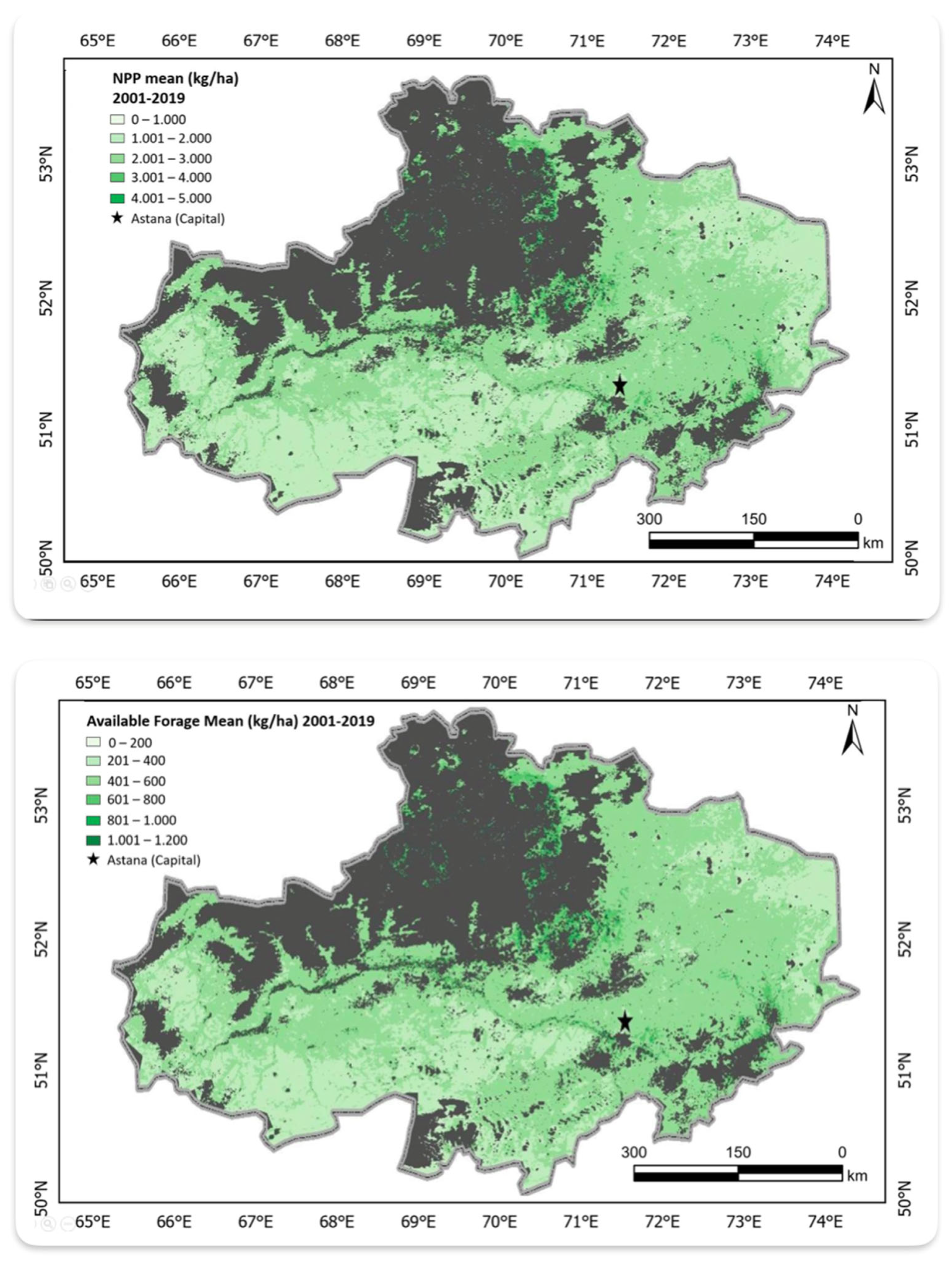
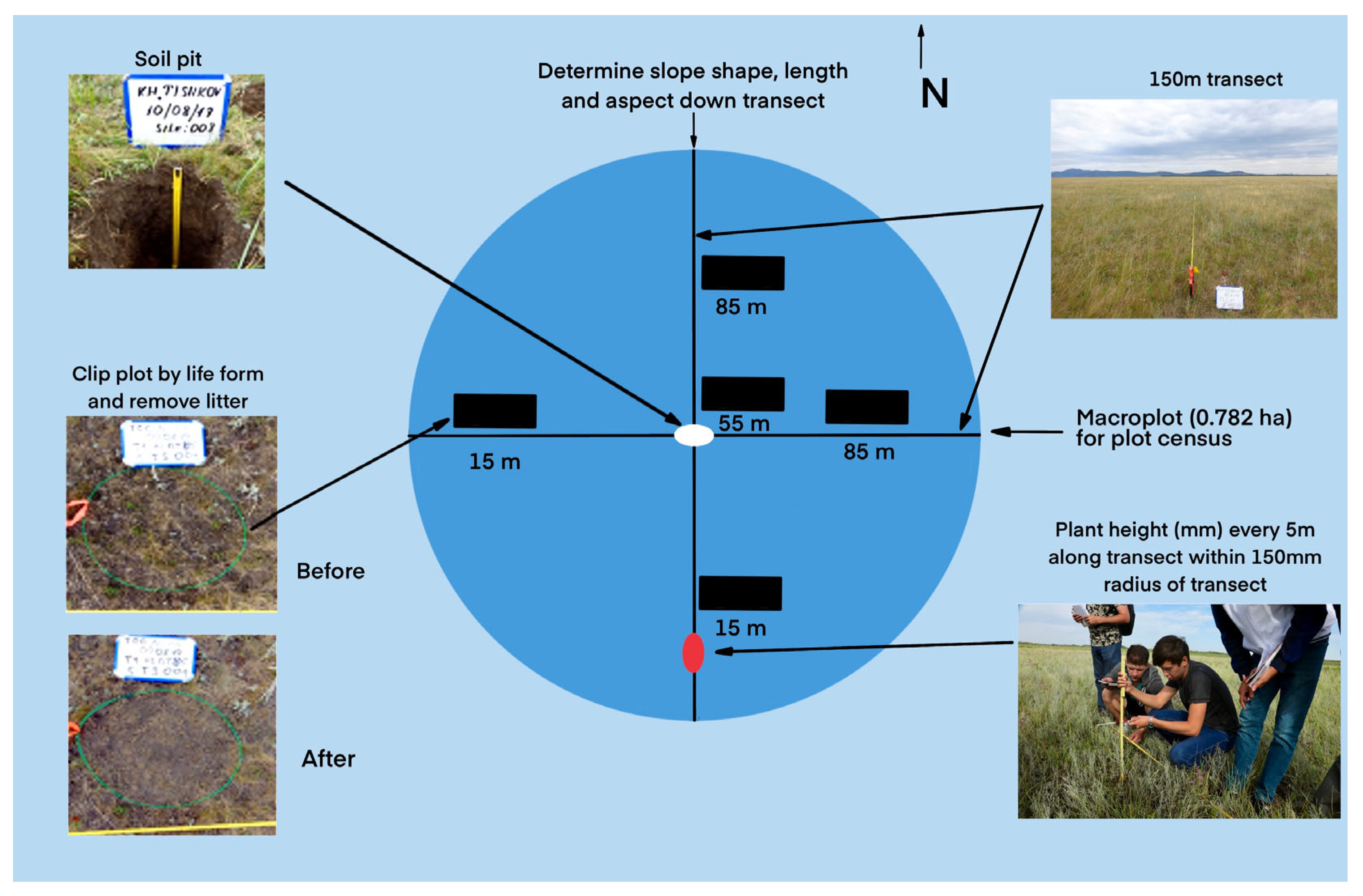
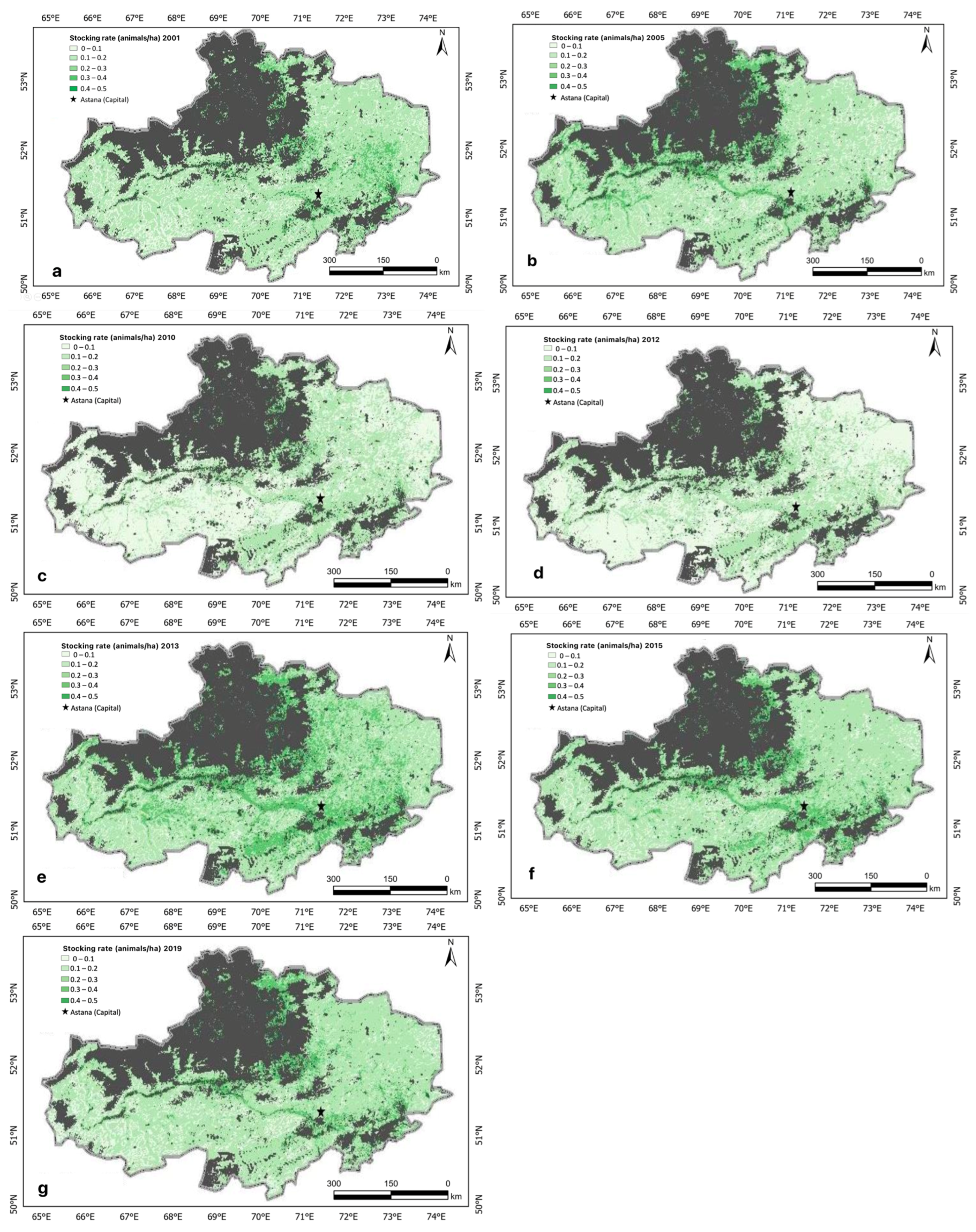

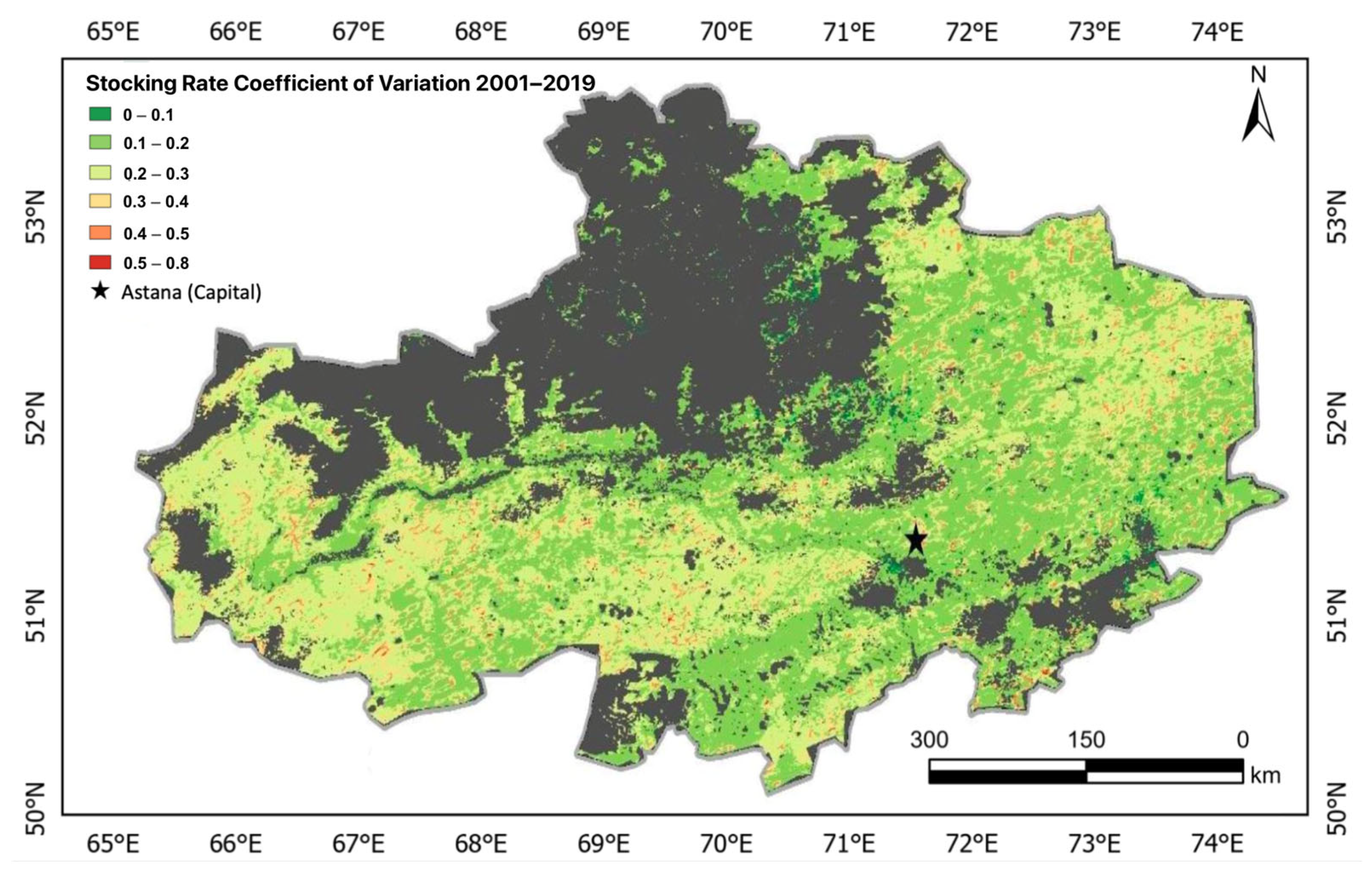
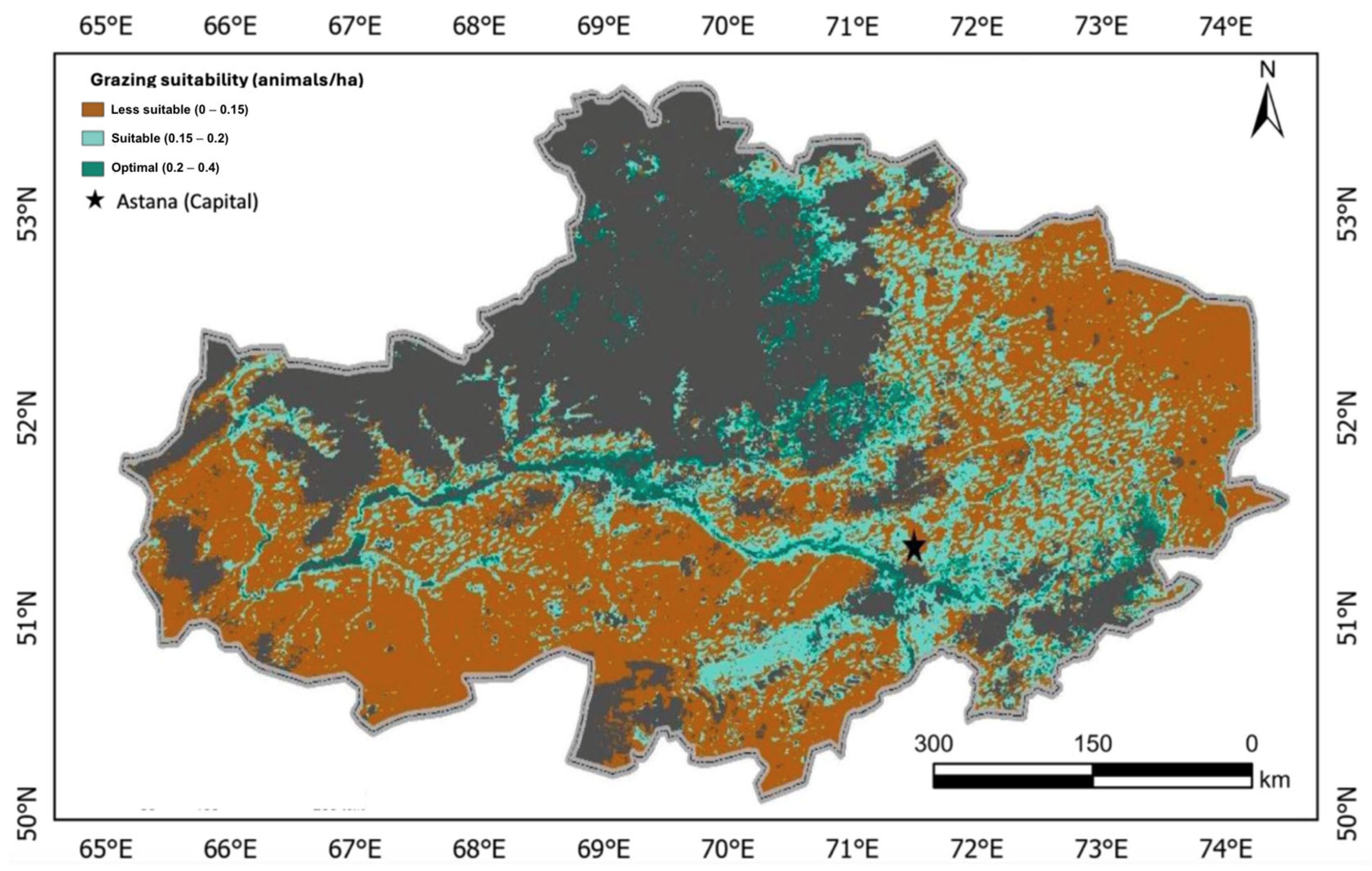
| Name | Spatial Resolution (m) | Temporal Range/Resolution |
|---|---|---|
| NPP(MOD17A3HGF) [29] | 500 m | 2001–2019/annual |
| Land use land cover (MCD12Q1/CGLS-LC100 collection 3) [30,31,32,33,34,35] | 2001–2019/annual | |
| 500 m/100 m | 2015–2019/annual | |
| Water (JRC Yearly/Monthly Water Classification History Layers) [36] | 30 m | 1984–2018/annual/monthly |
| Elevation (NASA SRTM Digital Elevation Data Version) [37] | 30 m | 2008/one-time |
Disclaimer/Publisher’s Note: The statements, opinions and data contained in all publications are solely those of the individual author(s) and contributor(s) and not of MDPI and/or the editor(s). MDPI and/or the editor(s) disclaim responsibility for any injury to people or property resulting from any ideas, methods, instructions or products referred to in the content. |
© 2025 by the authors. Licensee MDPI, Basel, Switzerland. This article is an open access article distributed under the terms and conditions of the Creative Commons Attribution (CC BY) license (https://creativecommons.org/licenses/by/4.0/).
Share and Cite
Qi, J.; Lin, Z.; Weltz, M.A.; Spaeth, K.E.; Iskakova, G.; Nesbit, J.; Toledo, D.; Yespolov, T.; Kussainova, M.; Makhmudova, L.K.; et al. A Geospatial Livestock-Carrying Capacity Model (GLCC) in the Akmola Oblast, Kazakhstan. Remote Sens. 2025, 17, 1477. https://doi.org/10.3390/rs17081477
Qi J, Lin Z, Weltz MA, Spaeth KE, Iskakova G, Nesbit J, Toledo D, Yespolov T, Kussainova M, Makhmudova LK, et al. A Geospatial Livestock-Carrying Capacity Model (GLCC) in the Akmola Oblast, Kazakhstan. Remote Sensing. 2025; 17(8):1477. https://doi.org/10.3390/rs17081477
Chicago/Turabian StyleQi, Jiaguo, Zihan Lin, Mark A. Weltz, Kenneth E. Spaeth, Gulnaz Iskakova, Jason Nesbit, David Toledo, Tlektes Yespolov, Maira Kussainova, Lyazzat K. Makhmudova, and et al. 2025. "A Geospatial Livestock-Carrying Capacity Model (GLCC) in the Akmola Oblast, Kazakhstan" Remote Sensing 17, no. 8: 1477. https://doi.org/10.3390/rs17081477
APA StyleQi, J., Lin, Z., Weltz, M. A., Spaeth, K. E., Iskakova, G., Nesbit, J., Toledo, D., Yespolov, T., Kussainova, M., Makhmudova, L. K., & Xin, X. (2025). A Geospatial Livestock-Carrying Capacity Model (GLCC) in the Akmola Oblast, Kazakhstan. Remote Sensing, 17(8), 1477. https://doi.org/10.3390/rs17081477










